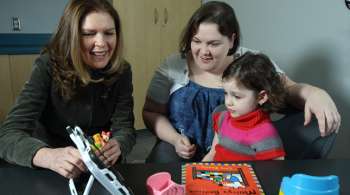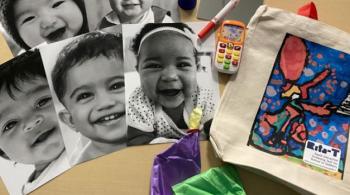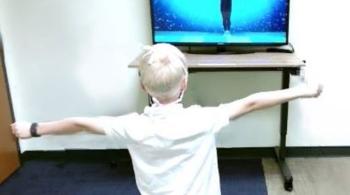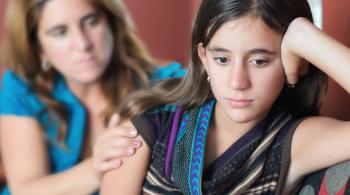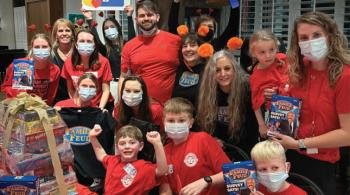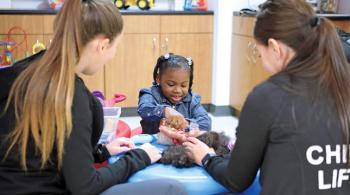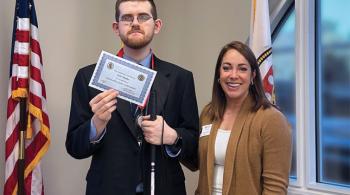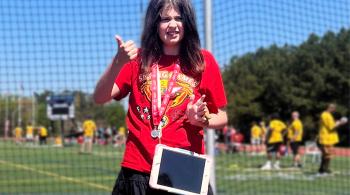Evidence suggests that children and teens with autism are at an increased risk for experiencing a mental health crisis. In this episode of Your Child’s Brain, we speak with a panel of experts about the co-occurrence of mental health issues in autistic children and teens, the signs and symptoms of mental health concerns, how those signs and symptoms can differ in young people with autism, and ways that parents can advocate for their child, not only in a crisis situation, but also in the classroom and the community. We also are going to discuss how one can learn more about autism spectrum disorder and research being conducted to better understand how best to help autistic individuals who seek care.
Speakers for this month's episode include:
- Dr. Ebony Holliday, a school psychologist and research scientist at the Center for Autism and Related Disorders
- Dr. Luke Kalb, director of the Informatics Program at the Center for Autism and Related Disorders and a faculty researcher in the Department of Neuropsychology. He is also an assistant professor in the Department of Mental Health at the Johns Hopkins Bloomberg School of Public Health.
- Dr. Katherine (Kate) McCalla, a clinical psychologist and assistant clinical director for the Center for Autism and Related Disorders
- Dr. Ericka Wodka, a pediatric neuropsychologist and the clinical director for the Center for Autism and Related Disorders and is an associate professor in the department of Psychiatry and Behavioral Sciences at Johns Hopkins University School of Medicine
Resources:
View Episode Transcription
Dr. Brad Schlaggar (BS): Welcome to Your Child's Brain, a podcast series produced by Kennedy Krieger Institute with assistance from WYPR. I'm Dr. Brad Schlaggar, pediatric neurologist and president and CEO of Kennedy Krieger Institute. Evidence shows that children and teens with autism are at an increased risk for experiencing a mental health crisis. Today we're going to speak with a panel of experts from Kennedy Krieger Institute's Center for Autism and Related Disorders about the co-occurrence of mental health issues in autistic children and teens, the signs and symptoms of mental health concerns, how those signs and symptoms can differ in young people with autism, and ways that parents can advocate for their child, not only in a crisis situation, but also day-to-day in the classroom and the community. We're also going to discuss how one can learn more about autism spectrum disorder and research being conducted to better understand how best to help autistic individuals who seek care. I'm joined by four of my colleagues at Kennedy Krieger Center for Autism and Related Disorders, which we call CARD, as we recognize April as Autism Acceptance Month. Please welcome Dr. Ebony Holliday, a school psychologist and research scientist at CARD. Dr. Katherine McCalla, a clinical psychologist and the assistant clinical director for CARD. Dr. Luke Kalb, director of the Informatics Program at CARD, a faculty researcher in the Department of neuropsychology at Kennedy Krieger, and an assistant professor in the department of mental health at the Johns Hopkins Bloomberg School of Public Health. Dr. Ericka Wodka, pediatric neuropsychologist, who's the clinical director for CARD and an associate professor in the department of psychiatry and behavioral sciences at the Johns Hopkins University School of Medicine. Welcome, everyone. Now, before we get started, I'd like to acknowledge that in the autism advocacy community, there are varying perspectives on language. Some prefer the use of person first language, for example, Johnny is a person with autism. Others prefer the use of identity first language, for example, Sally is an autistic person. At Kennedy Krieger, we believe that the most inclusive approach is to recognize and respect the range of perspectives here, use the language interchangeably, and whenever possible, ask an individual how they would like to be identified. With that, let's start with you, Ericka. Let's start with what changes we've seen recently with the number of children and teens diagnosed with autism. What's different from, say, five or 10 years ago?
Dr. Ericka Wodka (EW): In the past decade or so, I'd say our understanding of the full spectrum of autism has really grown and developed. This would include identifying symptoms that don't really show until later in childhood when maybe the social expectations increase a lot. [LAUGHTER] This could be reflected in changes to the diagnostic criteria back in 2013, where the requirement for symptoms to present an early childhood changed to include individuals where social changes emerge later. I would also say our understanding of the differences and the presentation of autism in boys and girls has grown. That can be reflected in changes to the diagnostic criteria as well. The nuances of the female presentation, I feel like, are now a little bit better understood. That includes some of the differences in how special interests may show or even the early signs that we know females can present with, which might include motor concerns. We also know that girls may be diagnosed later. Often, that first diagnosis can be co-occurring with mental health or other neuro-developmental conditions like anxiety or ADHD or learning disabilities, and that might happen before they present with autism later in life. We also just learned last week the Autism and Developmental Disabilities Monitoring Network or ADDM provided updates on the prevalence and sex demographics of autism. Their report showed that the prevalence of autism continues to rise being one in 36 in the US and that's a continued increase from one in 44 in 2018. Back in 2000, it was one in 150. The age of initial diagnosis didn't change in this report and remains around four years of age, but the gap between boys and girls narrowed a bit. It still exists, the boys are diagnosed more frequently than girls, but right now, according to this latest report, it was one girl for every 3.8 boys diagnosed. For the first time, the prevalence for females is greater than one percent. That's also new. I think from this report too, they identified that the co-occurrence of an intellectual disability is on the rise. That's about 30 percent co-occurring. Girls and Black children, actually, most frequently received that additional diagnosis of intellectual disability. Those were some other changes this report highlights. Last, there were some other piggybacking on that, some other interesting racial trends. For the first time, fewer white children were diagnosed with autism as compared to Hispanic and Black children. This really reflects a shift in the demographic composition of children identified with autism compared to previous years and really highlights that autism is common across all racial and socioeconomic groups, and really underscores the need for equitable and accessible screening services and supports for all children really.
BS: What's really clear is that some of the diagnostic disparities have narrowed over time, which I think is welcome, but also, points out, as you said, how common the diagnosis is. To the topic of mental health concerns, what do mental health concerns look like for children and teens with autism? How might those signs and symptoms differ from those in typically developing children? Ericka, maybe take the first crack. Luke, I know you have a perspective on this one as well.
EW: We know that autistic children are more likely to develop clinical symptoms of ADHD, anxiety, depression, mood, behavior disorders. We know that while some of the features of these co-occurring conditions overlap with symptoms we see on the spectrum of autism. For instance, children on the autism spectrum can be inattentive, they can have worries, they can be socially withdrawn, and all those symptoms overlap with ADHD, anxiety, depression. However, when the overlapping symptoms reach a level that they require specific treatment or intervention, that's when it's appropriate to provide a co-occurring mental health diagnosis in addition to the autism. I think it's also important to note that the repetitive behaviors and social challenges characteristic of autism can interact sometimes with these symptoms of the co-occurring conditions, and at times worsen the child's ability to participate in daily settings. The interventions often need to be modified to consider the co-occurrence and that interplay of the autism symptomatology with the symptoms of other mental health conditions. An example of this might be that anxiety can often be triggered by some of the overwhelming sensory experiences that are common with autism and that might need special consideration to treatment approaches. As I talk about treatment approaches, I think Dr. Kalb wants to talk a little bit about some of our treatment or research related to treatment.
Dr. Luke Kalb (LK): I would mention two things. Historically in autism, when there was any concerns about a mental health issue that was co-occurring with autism, just like Dr. Wodka explain, anxiety or depression or behavior problems. There was unfortunately this issue of what we call diagnostic overshadowing, and that's where we assumed that what was going on was a product of the autism. Now we know today that these conditions can be identified separately from autism and treated as such. We have a lot of different specialists at the Center for Autism and Related Disorders, psychiatrists, psychologists that are specifically trained to treat these issues. One example would be Dr. Amy Keefer, who is one of our clinical directors and a child psychologist, does anxiety treatment for very young children with autism. She has a study going on called the dinos study. It's a dinosaur theme study to treat anxiety in children's seven years and younger, because anxiety is one of the symptoms that emerges very early in childhood. She's also adapting that treatment, which takes a cognitive behavioral therapy approach for children who have minimal language as well. That's really important is for Dr. Keefer and for the field at large is that a lot of our treatments are fit for individuals that have verbal language, but we know a large proportion of children with autism don't have that. We need to adjust our treatments just like Dr. Keefer is doing in that study.
BS: What happens when an autistic child has what might be referred to and I'll use non-clinical language, but I think it's pretty descriptive. We know what we're referring to here. The meltdown, what's happening there, Kate?
Dr. Katherine (Kate) McCalla (KM): When most people think about a meltdown, they think about the behavior that they've seen when somebody is experiencing a really high level of distress or dysregulation or frustration. What you might see from the outside usually includes some kind of expression of that dysregulation. You might see a child who is screaming or crying or dropping to the floor or flailing their body. You could also see a behavior that might hurt another person, so like hitting or kicking or pushing. Sometimes that autistic individual might also engage in some behavior that might hurt their own body. Something like banging their head against a hard surface or scratching their own skin. Knowing what that meltdown looks like is really just the first step in understanding what is happening during a meltdown. As a therapist and a psychologist who's been working with autistic kids for a long time, it's incredibly important for me to understand what's going on under the surface and to understand why that meltdown might be occurring. It's also really important for me to help parents understand what's going on under the surface and, if it's appropriate, to help that autistic individual understand what's going on. There's some kind of common meltdown triggers that I consider when I'm working with individuals and families and some of those things are that the person is not able to effectively communicate with other people, things that they want, things that they need. They also might not be able to access something that's really important to them. Then sometimes we see meltdowns triggered by changes in routine, especially if they no longer know what to expect or no longer know what's happening next for them. Then one other possible meltdown trigger I really want to include that Ericka mentioned earlier is that there may be something going on in the sensory environment that feels very overwhelming. An example of this is being surrounded by an unpredictable loud noise that is aversive. That's what we see on the surface and a little bit of what's going on underneath.
BS: If you can recognize the triggers, that means you might be able to come up with the strategies to avoid the triggers and therefore avoid the meltdown. Can you talk a bit more about preventive strategies?
KM: Yes. This is what we hope for most of the time we have to be able to prevent meltdowns instead of having to deal with them on the backend after they've already occurred. There are lots of things that parents, caregivers, teachers and other professionals can do to prevent meltdowns. One of the things that I often encourage family members to do first is to try to become a detective and to really seek to understand what's going on with their child by closely observing what's happening immediately before they see some of that meltdown behavior, during the meltdown behavior, and then also afterwards. Sometimes that's very obvious. Sometimes a child just means they're pull-up changed, or sometimes you have turned off the television in the middle of their favorite program without giving them any warning and those things are upsetting. Sometimes it's more complicated than that and you don't know what's triggering the meltdown immediately. When that happens, I really encourage families and other caregivers to continue to pay close attention. Maybe write down some notes about when this is happening, what they're seeing, and try to figure out the pattern of what's going on there. Sometimes it takes a little while and you need to collect a little bit of data, maybe for a week or so. But usually families are able to figure out some of the underlying reasons for what's happening with their child. Once they better understand that, then they can figure out the most appropriate strategy so that child can get their needs met without needing to display those distressed behaviors. Some of the ways families can help get those needs met are by modifying the environment around the child or teaching that child a new skill. There's lots of ways parents can help on both ends of that.
BS: Luke, can you speak to whether this approach has been tested through clinical trial?
LK: Thanks for asking Brad. We currently have a clinical trial going on for a crisis prevention study. That study’s funded through the Kennedy Krieger Institute and their Goldstein Award. Our goal is to really get the strategies in place before these meltdowns or crises occur. The way we do that is we define a crisis across four stages. There's a baseline where your child has irregular behavior, but when things become more difficult, when you see a rise or we define it like ea wave. At that pre-crisis stage, before things become out of control, is a great place to start putting these strategies that Kate talked about in practice. Other things you can do is when things start to emerge and your child those behaviors is for parents to stay calm and collected. What's really important is a child will feed off of your behaviors and they could even mirror your behaviors. Being able to be really in control in those difficult moments is important. Secondly, we recommend making really, you can make small changes to your environment to keep everyone safe. That can be like putting sharp objects out of the way, or maybe some objects in their environment that can cause conflict between siblings or between parent-child. You can remove those things from the environment and we also recommend connecting with resources before things become too difficult as well. That's making sure your pediatrician or being aware of any other mental health resources in your community are available to you so you can connect to those things and have them in place. The third stage would be a crisis and so that's when things become really acute. Then the fourth stage is post-crisis and that's really organizing yourself and your caregivers and the providers, educators together to figure out what happened and come up with a plan to try to avoid that cycle from reoccurring.
BS: So Kate, maybe underscore a bit about the importance of during that meltdown, staying calm. Aapproaches to take in that moment. It's one thing to talk about, staying calm, it's another to deliver on it. What do you recommend there?
KM: Families often are trying to figure out how to respond and as Luke said, the first part is for the parent or caregiver, maybe teacher to check-in with themselves and to be aware of their own emotional reaction to the child that is distressed and disregulated in front of them. It is almost impossible to be with a child that you love and to not feel upset when they are so upset. You need to check in within yourself potentially use a coping strategy like taking a handful of deep breaths or counting to five, or reminding yourself, we have been through this before together. I have the skills I need to parent my child. We have gotten through this and then to take another little mental moment before choosing to do anything to interact with the child. I also really want to emphasize that at times, a particular parent or caregiver just may not have all the resources emotionally that they need to respond in a situation. If that is the case, we really hope that they are able to find another person who can be supportive. Maybe it's another parent, maybe it's the parents’ sibling or a grandparent can step in and help manage that child in that distressed moment.
BS: We've been talking about meltdowns and crisis. Maybe it'd be a good idea for us to just define what we mean by. What do you hear in clinic Kate and perhaps Luke from a research perspective, how do we define or measure the crisis?
KM: Typically when we're thinking of a crisis, some of the things that we're seeing are similar to what we're seeing when we're thinking about a meltdown. But essentially it's become more acute and less safe. The autistic individual may no longer be safe physically because they are engaging in more severe self-injury. Potentially, the people around them that are trying to support them may no longer be safe because there is so much aggression that that person is not safe. The other thing I want to mention is that at times the autistic individual may be so upset about something that they may be having some suicidal ideation or thinking about self-harm from that perspective, and so the crisis is when the people are no longer safe and we don't have the resources or supports to get out of that unsafe situation. There needs to be outside intervention or support or help from someone else to be able to pull the autistic individual and their loved ones out of that unsafe scenario.
LK: We have essentially taken that definition and operationalized it and we actually have a measure, it's called the mental health crisis assessment scale and it's the only parent report measure of crisis that I'm aware of in the field of autism, and so this is a very short measure that I've developed with my colleague, Dr. Roma Vasa, who's a child psychiatrist at CARD, and it asks families, it has three sections, it asks them about common behaviors related to crisis. The second section they then rate the dangerousness of those behaviors. That's things like feeling unsafe. Whether other individuals from the family or community have said they have concerns about safety, and then the third part is whether the families or the caregiver feels like they have the resources to respond in difficult times to those behaviors, and we have a cutoff on that measure, and we've actually done studies on prevalence of crises in two different clinics. One is in CARD and one is a clinic at WellSpan Health in upper Pennsylvania and in over 400 kids, we found about one in four to one in five met criteria for being a crisis who would receive care in the clinic. That suggests that they are quite prevalent, and I'm glad it's the topic of this discussion.
BS: It seems like it's fair to say that there's a continuum of meltdown to crisis. When you think about causes and approaches to addressing the crisis, for example. Do you think about that also in continuum space, or are there other separable strategies that you take once you are in crisis mode that are clearly different from the meltdown mode?
KM: I think that you are correct in thinking abou it as a continuum. There are very similar causes for meltdowns and crises, and it's really more about the severity and the level of support that the people need who are in either a meltdown or a crisis. I think the response can be different when we are really in a crisis because there is a need for additional support, more responding, more concern about safety. Luke mentioned before, we want to make sure that we're putting away dangerous items. We want to make sure that we're putting away dangerous items in a meltdown for sure, but it might be even more critical that we are making the environment very safe if a person is in a crisis and we're maintaining that safe environment in a crisis.
BS: We've heard a lot recently I hope about 988. Can we talk about the role of 988 in contrast to the use of 911 or emergency room or what other options parents have or caregivers have in that moment? When do we engage 988? When do we take other options? Kate.
KM: 988 is the national suicide and crisis hot line, so I'm sure some of you have heard about this before but this is really an addition to 911 specific for people who are having mental health issues or related distress. When a person calls 988 or texts 988, that contact is made with a call crisis center in the State of Maryland that's going to provide support over the phone or via text and then it's going to try to connect that person with resources in their local community. So this is different from 911. If you call 911 you're likely to get emergency response to your location, so we are hopeful that people who are experiencing more mental health-related crisis will take advantage of the 988 option to get support on the phone and then linked up to local services.
LK: I agree, but one idea too is there are times when things become so acute that you need immediate response; you need help onsite, and so some of the recommendations we have is if possible asking if there's any responder that has experience in autism or developmental disabilities, at minimum, some mental health experience. There is lots of training going on across the country for emergency responders and police units and so it may be possible that a unit is dedicated to that in your area and it would be great if they responded. Again back to the prevention idea, is if you foresee a crisis or have experienced a crisis with your child, having a discussion with your local emergency responders if the parents feel comfortable and talking about your child and their specific needs so there can be some kind of preparation for that. Third is if that event does happen, one thing we do in our studies we have a quick hand-off sheet for families where they can just briefly describe their child and their needs, what helps calm them down, best ways to communicate with them. When a responder does come, they can give them this hand off sheet really quickly in the moment to try to make things go better because unfortunately, there has been really unfortunate incidents that have happened with children across the country involving 911 and emergency responders and it's really important that we prepare everyone as best as possible.
BS: We're going to switch gears now and move into schools. So Ebony, let's get into this discussion about schools. What tips can you give to help families, children with autism, to navigate school successfully, and then what to do when there are problems in the school setting?
Dr. Ebony Holliday (EH): Yes, great questions. Navigating the school journey as a parent or a caregiver of an autistic child, the reality is that it can occasionally if not often feel overwhelming and stressful at times. That is a reality that's there, but there are some key strategies that families can engage in to really better support their child in achieving those optimal educational outcomes that we would like to see. The first thing I want to talk about is this concept of partnering or partnership with your child's school. We know that these school and family or school-home partnerships are really essential for all students overall, but even more so for students with disabilities and of course including autism. It's not just that these home-school partnerships sound good or have face validity, but educational research really shows us that partnerships can positively impact and help improve the school outcomes and success. Partnerships is something that I really encourage and I really think is something that we should push more for our families as well. I'm going to explain a bit what partnership and partnering, what that can mean. We know that these concepts and these actions can include things like regular communication. It might be sharing or exchanging information, it might look like collaboration or working together on a common goal and it's also going to include involvement. It's going to include engagement and also building trust and relationships and that's key also with school team is that trust piece, with families being able to trust the school with the care of their child and the educational success of their child as well. The reality is that these concepts like communication and collaboration and partnership, they take time and they take effort. It might not be something that just automatically happens, and that's with both sides; with both home and school. It has to be intentional and both sides have to be willing to work together, but we do know it's something that's invaluable for students especially our autistic students and children and so it's worth that time and energy that we can put into it. My first tip is really that working to establish that partnership and looking at building those relationships. Another key area that I'll mention is for families to really understand and explain to others and sometimes that's the key piece that explaining what their child's strengths and areas of need are and how those areas impact, and by that, either supporting or hindering their school experiences and outcomes. I've always been a big believer that parents and families are the experts on their children, and so that flow or that transfer of information from home and from families to the school team it's critical for teachers and it's critical for that school team to have that and then for the team to be able to use that for educational planning. Specifically, I would say, as we're talking about strengths and needs, how does your child's autism diagnosis impact their functioning? How does it impact the way they interact in their environments? One thing I'll mention too is we know that there is much heterogeneity in autism, and by that we mean there's a lot of diversity and a lot of variability in autism and so those strengths and needs of one child may look very different from the strengths and needs of another child. For families to be able to not only understand but also convey that information related to maybe these are the ways that the social communication differences look and manifest for my child or these are the special interest and the sensory sensitivities that my child has. This is how it shows up at home, this is how we address it, and this is how we provide support for it. That information and conveying that information to the schools and to the school team can be really important and really valuable for educational planning. It may be something where families might not know every single activity that is going on in schools, but the conversations and that information about what's happening at home and those strengths and needs there that can facilitate effective planning for the school environment. Just a brief example. It might be that parents are noticing that it's challenging for their child when they go out in the community in stores or in restaurants. That information could be helpful for the school team to do some preventative planning around strategies for maybe the crowded lunch room. Maybe the lunch room can be a trigger or maybe for a high school student transitioning in the hallways it's crowded, that could cause some difficulties. Even though it's not a direct comparison, that information about what's going on in the community and relaying that to the school team is going to help the school team to plan and to better support the child in that environment. Overall my primary tips, really know your child's strengths and needs, convey that information to the schools and then what I mentioned initially which is working with the school to really build those partnerships. That's what I would give that overview of.
BS: There's this concept of least restrictive environment that is an important principle. I think it's important for us to unpack what that means and for parents to understand whether their child is indeed in the least restrictive environment and whether the environment they're in is appropriate for their current needs. Let's define that term. It's kind of jargony. What does it mean? Where does it come from and how do parents navigate the concept?
EH: Definitely an important question there and I'm probably going to describe with some jargon first and then I'll break it down and give some examples. The least restrictive environment or the LRE, as sometimes we call it in the educational world, it's really a guiding principle within IDEA which is the Individuals with Disabilities Education Act. That's really what's guiding IEPs and special education services. So it's essentially this principle that dictates that children or students with disabilities are educated with or have access to children without disabilities to the greatest extent possible. That's that overarching theme or that guiding principle, but it's also with the understanding that if we have to remove students with disabilities from that general education environment which does happen and it's a reality for example maybe to a separate classroom, a self-contained classroom, it might be to a separate school,if that happens, it really should only occur if the level of impact of that child's disability or the severity is at a point where learning in that general education classroom can't really occur as we want it to. It's not able to be appropriately achieved even if we have that IEP and those supplementary aids and services in place. Again, just that summary, we should be educating students with disabilities alongside students without disabilities. However, there is a caveat that we know level of impact and severity may differ with all students. If that is the case, we need to make sure that it's only because we cannot properly or appropriately implement the IEP or implement those supports strictly in a general education setting or environment. The other part about the least restrictive environment or the LRE is that it's going to look different for each child and it's going to be developed and outlined in that IEP. Just for some examples, there may be some autistic students and their LRE will be the general education classroom and maybe their program of instruction, and maybe if they have related services that's going to be delivered by general and special education teachers we’ll say, and those related service providers. Those students are going to have access throughout the day to other students without disabilities in their primary classroom. For those students, that is their LRE. There may be another student whose needs are a little bit more significant, and perhaps that desire level of learning wasn't able to take place with the IEP supports in a general education classroom. Maybe they're in a separate classroom. Maybe it's smaller they're with other children or other students with disabilities, and in that environment they have more access to specialized supports to a special education teacher throughout the day. For that child, maybe they still though go to lunch and recess or PE, with their peers without disabilities, and they still are able to be educated in that same school environment. That arrangement that's going to be outlined in their IEP, that is their least restrictive environment. Again, it's going to differ, and then the last example I'll give is that we know that there are autistic children and students who have a greater level of impairment for their autism or co-occurring conditions. They're in need of an even higher level of support and services. Maybe that's only available outside of the general education setting to ensure they have an appropriate education and so that might be within a separate school, so settings that are intentionally designed and they're intentionally staffed to meet those specific needs of students with disabilities. That might be our own Kennedy Krieger Institute schools with educational programming. There are these programs in Sheppard Pratt system. It might be Maryland School for the Deaf, it might be Maryland School for the Blind. There are a range of schools that really function to meet the specific and individualized needs of students with disabilities.
BS: What can parents do to best advocate for their children in these settings and maybe address some of the do's and don'ts to have the best outcome and to avoid clashes, contentiousness. What would you say?
EH: I think advocacy is so important, and really parents are natural advocates. Because there is that connection and it's that investment in your child's well-being. If you're just a natural advocate in that space, and advocacy is really ongoing. You have to stay informed and you have to stay educated on a variety of issues, and so maybe just a few do's for advocacy. I would mention one last time I'm going to push again building relationships with schools. I think that's really important in your child's team. Gathering information and really doing your own research to learn more, and that might be about the IEP process. That might be about behavioral plans. It could be about procedures for school discipline, and really there's so much information out there. Sometimes it can be overwhelming all of that information. But finding a few trusted organizations or websites can be helpful. For example there's Pathfinders for Autism. There's Parents’ Place of Maryland. We have here our own Project HEAL which is health education, advocacy, and law. They have a really great parent resource section that I definitely said colleagues and parents to get some information. They have a nice section where there is sample forms and templates that families can really use to help them in this process, and so that can be really helpful for families. I think you can also learn and enhance your advocacy through skills like connecting with other advocates and connecting with other parents who may have been through the process for a period of time and have some wisdom and experience to share. Partnering with other families can be powerful. I would say sometimes it is easy to become intimidated for families by a lot of things that is processed by the school team you're seeing in these meetings, and there may be five, six, seven other people that are across the table from you. Or being intimidated by the formal processes or all the forms that are involved, and there may be a tendency for families to sometimes just defer to the quote unquote experts in the school team or to take a back seat at meetings. I would encourage families to not be intimidated. I would encourage families to speak up to claim your role as a really important and an equal contributor of the IEP or of the school team and also as an expert on your child. That's the one and at the same time, I would also say, you can be a strong advocate without being adversarial. Sometimes that can be tough too because there may have been previous experiences that families have had with schools that have maybe made you put your guard up a little bit and now maybe you're in another environment and you're working with a new teacher, but your guard is still up. Sometimes that can cause difficulty with supporting and building those relationships. But really it's a delicate balance with having to push a little bit, but not to the extent where it's negatively impacting the relationship or the partnerships that we want to build. Overall, advocacy, know your child, understand their needs. You want to share relevant information and really stay connected with others.
BS: I'm going to go back to you, Luke and then Ericka, let's close with what can folks who want to be more knowledgeable about autism spectrum disorder and be involved in helping improve the lives of those who are autistic. What can they do? What are some of the things that we all can contribute to?
LK: One is you can participate in research. As a researcher, you know, I'm always encouraging families to join studies. You can learn more about the research that goes on at Kennedy Krieger Institute on their web page, which the links will link you to direct studies and then an overall registry where you can learn about a variety of different studies. Second, I would say is being inclusive. Today the numbers are moving in a direction where everybody may end up knowing someone that has autism. Whether it's a family member or a friend or a colleague, we’re coming to a point where we need to be more accepting and open and aware, sensitive, knowledgeable about people with autism and their needs, and so I'd like this to be moved towards a more inclusive society.
EW: I think increasing awareness and understanding of both the strengths and the challenges that neurodiverse individuals face day to day is important. As part of Autism Acceptance Month in April, CARD is hosting weekly webinars at noon on Thursdays, which includes topics and presentations by self-advocates, providers, researchers and community stakeholders, and anyone can register for these webinars. The website to register will be attached to this podcast and we hope you can join us for these important talks. But I think further action by the community also should include schoolwide trainings on the needs of autistic individuals, and that's both for students and for teachers, and that's from lower elementary all the way through higher education institutions. But beyond schools, thinking about opportunities for education within your place of worship, maybe philanthropic groups, your workplace and then along workplace lines. Thinking about supportive employment opportunities and specific job training. Your workplaces can offer those on the spectrum. Because we know that the transition to adulthood is really difficult for those that are on the autism spectrum, and I think we all need to do better in supporting this transition for everybody on the spectrum. Through all these things, the goal is really to identify what accommodations and supports will help individuals reach their goals, increase their independence, their self-determination, and just overall satisfaction.
BS: We've called out a whole host of resources I think each of you have. We have an opportunity to link to those resources on this episode’s page, so we can include that. Thank you to our guests for this in-depth discussion. We hope you, our listeners have found the information we provided helpful and that you'll consider sharing this podcast and rating it. You can check out our entire library of topics on your child's brain at WYPR.org, Kennedy Krieger.org, WYPR.org/Studios, or wherever you get your podcasts, You’ve been listening to Your Child’s Brain. Your Child's brain is produced by Kennedy Krieger Institute with assistance from WYPR and producer Spencer Bryant. Please join us next time as we examine the mysteries of your child's brain.

